MXL V69 Mogami Edition Mod

MXL V69ME Modification
Monday, September 26, 2022

I’ve had an MXL V69 Mogami Edition tube mic sitting around for several years. It’s an inexpensive tube mic, cardioid only, made in China. It uses an unusual circuit, with an MXL branded 12AT7 dual triode tube feeding a transistor output circuit instead of a transformer. The two triodes are wired in parallel, with a feedback capacitor from plate to grid forming a charge amplifier as the input stage. The tube is coupled via an electrolytic capacitor to an FET phase splitter much like you find in a Schoeps mic circuit. The phase splitter feeds a pair of NPN darlington output transistors which drive the output XLR through another pair of electrolytic capacitors. In all, he signal passes through 5 electrolytic coupling capacitors and 3 stages of amplification using tube, FET, and NPNs. There seems to be some high frequency roll off built into the circuit to compensate for the capsule’s high frequency peak.
I bought this mic second hand, and the previous owner had modified it a bit, so it’s possible it isn’t exactly like a factory fresh V69ME. The inner layers of screen have been removed from the headbasket, and I believe several of the electrolytic caps in the signal path had been changed.
Here’s a frequency sweep before I started modification.

Since I measured at 10” (25cm) from the speaker, there should be a smooth rise in bass response below 200 Hz. The mic sounded a bit thin in the bass, and it measures a bit down. The upper mids from 2K to 7KHz roll off gently due to the electronic EQ, making the mic sound a bit dark until it reaches 8K to 16KHz, where the capsule gets very zippy. In all, it’s a strange mix of dark mids and zingy highs which didn’t work on many voices or instruments. So the mic wasn’t used. The tube was noisy and needed to be changed, but really the mic needed a complete rebuild.
I thought about putting a C-12 style tube circuit in it, but the power supply isn’t suited for that and would need to be replaced or gutted and rebuilt. I have a Mic-Parts T-84 which is a recreation of the Neumann KM-84 circuit with an RK-47 capsule. It’s a great mic. Quiet, sensitive, with a vintage character. A minimalist circuit. Capsule, NOS JFET, one high quality film coupling cap, and a copy of Neumann’s transformer. Four parts in the signal path. I decided not to mess with a tube, and build another T-84. It has a vintage vibe without sounding weird or being specialized. Works on everything and is magic on some voices and guitars.
Swapping the RK-47 was simply a matter of removing 4 mounting screws from the MXL capsule and mounting the new one to the saddle with 2 screws. A quick listen showed the RK-47 wasn’t a good match for MXL’s rolled off frequency response, and noise was unacceptable, so the mic was gutted and the T-84 kit was put together.
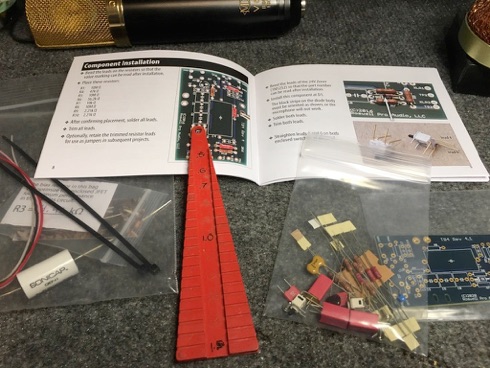
The kit is typical of Mic-Parts kits, with a comprehensive color instruction manual, gold over nickel plated PC boards, and all parts, including an individually selected and biased JFET. There are switches on the board for omni or cardioid pattern, and a pad for loud sources which also reduces the small amount of second harmonic the mic produces, just like a real KM-84.
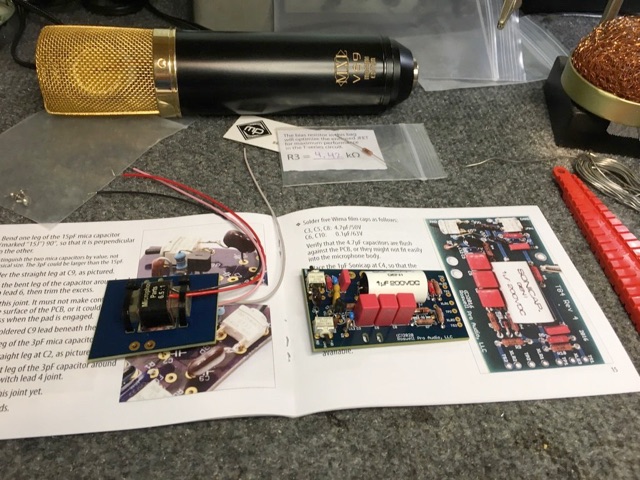
A couple of hours of careful soldering, and the boards are complete, cleaned, and double checked.
Then comes the only hack-ish part of this upgrade. The T-84 PC board isn’t intended for this chassis, so I picked the closest set of mounting ears on the side rails, bent one pair away from the circuit board with pliers, and screwed the FET board to one set of ears and the transformer to another on the opposite side. The V69 has more mounting ears on the frame than needed, but not all the holes are tapped for screws. However it does fit nicely. All that remains is soldering the transformer leads, capsule leads, and replacing the 7-pin XLR insert with a normal 3-pin insert and soldering those leads. The mic runs on normal 48V phantom power now, no separate power supply needed.
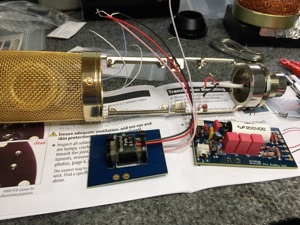

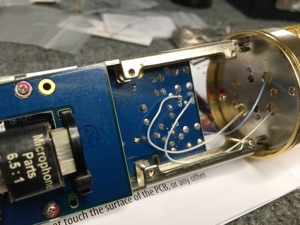
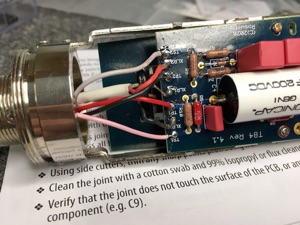
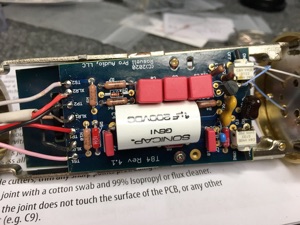
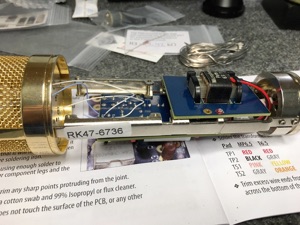
PAD SWITCH
PATTERN SWITCH
It worked right off the bat. The end result is a new mic using nothing but the shell of the V69. It’s quiet, sensitive, and has that easy, natural sound that makes old KM-84s worth big bucks.

The bass response is full down to 30Hz, and can be extended by changing one capacitor, but 30 is perfect for most sources. The all-important mids are flat and natural. There is a 2.5dB rise in the “presence” region from 4 to 7KHz, a 2dB dip in the sibilance range from 8-12KHz, and some unexaggerated air above that. No wonder the RK-47 is M-P’s best selling capsule.
UPDATE: When I told Matt at Mic-Parts what I’d done, he thought about the idea and came up with a different take on a JFET / V-69ME. Same basic KM-84 circuit, but with a different FET and transformer, and a cardioid version of Roswell’s new “no EQ needed” ’67 capsule. Dang, that would be sweet! Especially a 67 capsule with a flat top end. Check it out.
https://microphone-parts.com/collections/mod-kits/products/v69-fet-microphone-upgrade-kit

